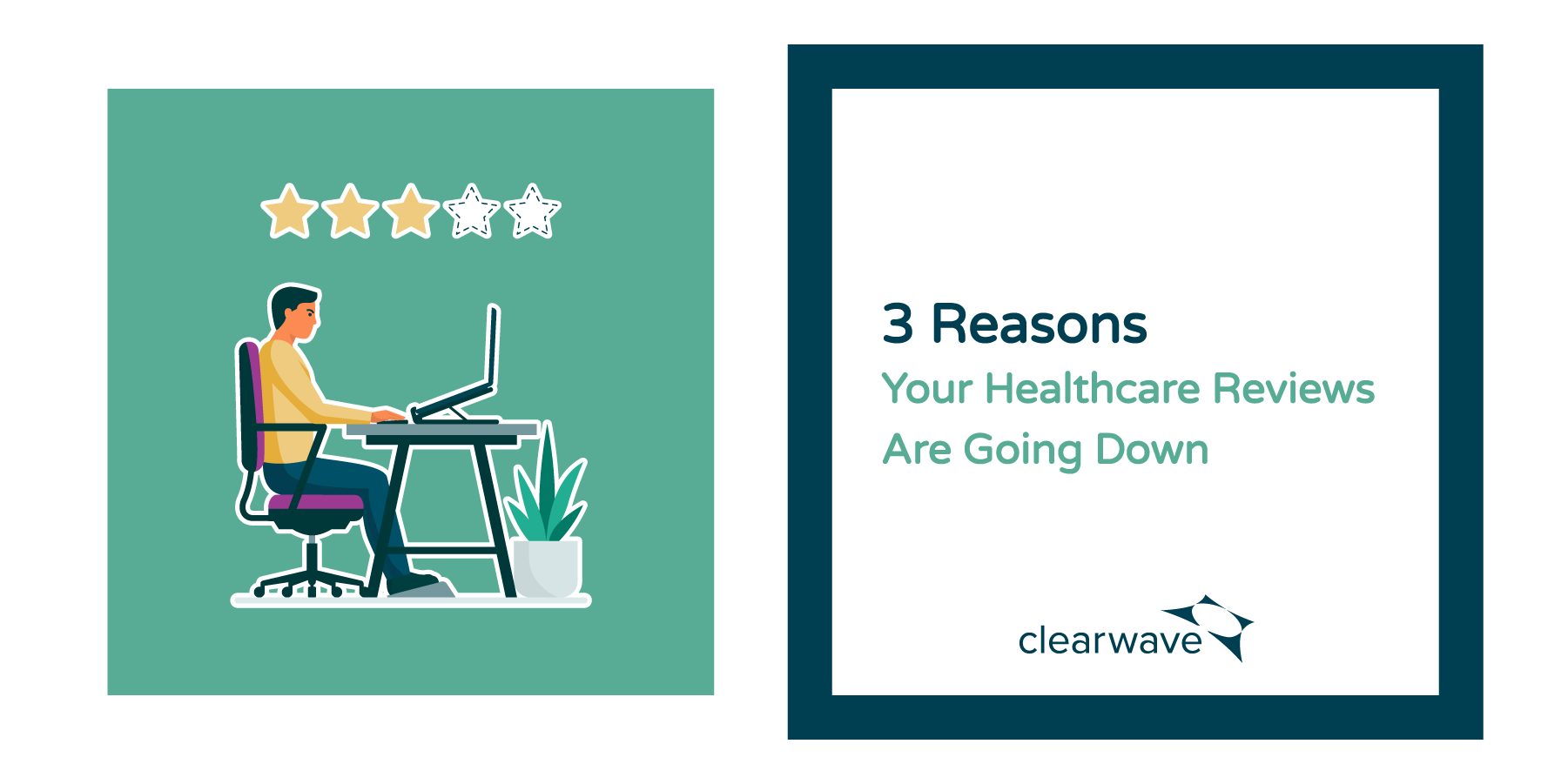3 Reasons Your Healthcare Reviews Are Going Down

By Chloe From Clearwave | February 22, 2024
Positive online reviews are crucial for healthcare practices to attract and retain patients in a competitive, internet-driven environment. With 74% of patients relying on reviews to choose a new doctor, maintaining a stellar reputation is key to your bottom line. If you’ve noticed your reviews slipping recently, improving your patients’ experience could provide the boost your practice needs.
Here are three reasons why your healthcare reviews may be going down, and what to do about it!
1. Long Wait Times Are Frustrating Patients
Between travel time and sitting in the waiting room, visiting the doctor often requires a big time commitment from patients. In fact, 2 out of 5 patients report feeling frustrated by long in-office wait times before their appointments even begin. With busy schedules, even small amounts of wasted time can leave patients disgruntled.
By speciality the amount of disgruntlement can differ, consider oncology patients who often come to the office more than once a week, family practices who bring in multiple children at a time, or orthopedic patients who may be in pain.
As Sydnie Murphy from Nebraska Ortho notes, “We see a lot of patients on scooters, crutches and boots. They’re in pain, and some may have been waiting months to see their specialist.” These patients want relief and answers, not more time standing in line or sitting waiting for their turn. Murphy further states, “Being able to get them checked in and seated fast, rather than waiting in a long line just to check in, has been huge.”
Streamlining your check-in process and evaluating scheduling gaps can help cut down on lag and keep patients happier. Implementing self-service kiosks for check-in allows patients to update their information, sign forms and even pay co-pays upon arrival without waiting for front desk personnel.
For example, with Clearwave’s self-service kiosks, Complete Women’s Care OBGYN saw wait times drop by 90%, which is huge for pregnant uncomfortable patients or those with newborns. Additionally, practices see an average check-in time of 3 minutes and an express check-in time of just 90 seconds for pre-registered patients.
Streamlining these administrative tasks through technology optimizes patient flow, significantly cutting down on in-office wait times that frustrate patients. With 68% ranking quick check-in as highly important, utilizing automated processes provides a better experience, and in return higher ratings!
2. Staff Burdens Are Impacting Patient Experience
Your administrative staff are the first faces your patients see when walking in and often they can make or break a patient’s start to their journey. Unfortunately, 1/3 of patients report having switched doctors in the past specifically due to unfriendly staff interactions. From rushed appointments to distracted service, poor communication causes patients to feel devalued and damages your practice’s reputation.
Emphasizing compassionate, attentive care in your office procedures and policies can turn this around. Implementing self-service options for scheduling and check-in alleviates bottlenecks that contribute to harried appointments and disgruntled staff and patients. Additionally, kiosks streamline administrative tasks like payments and paperwork, freeing up staff to guide patients personally, rather than focusing on checking boxes and asking for past-due balances in awkward situations.
With scheduling and check-in addressed digitally, staff can devote their full attention to delivering thoughtful, stress-free visits and answering patient questions. While there is a common misconception that self-check-in can make the process feel disconnected or disingenuous for patients, practices are actually seeing the opposite response from patients.
Providing excellent clinical care is at the core of every practice, but compassion goes a long way. Automation enables staff to focus completely on personal interactions, encouraging more attentive and meaningful conversations that make patients feel cared for.
One area you can lean into to remove staff burdens and support genuine patient-to-staff interactions, beyond registration, is clinical intake. By providing patients the ability to pre-check-in at home, practices can capture clinical intake digitally prior to the patient appointment. Patients can conveniently complete detailed medical history and reason for visit information on their own time before arriving at the office. Then, they can get right to the point upon entering the exam room, versus being asked sometimes challenging questions over face-to-face sessions with you clinical staff.
This approach further streamlines the in-office experience for patients by reducing in-office registration times and intake questions during valuable exam time. Investing in systems that simplify workflows ultimately allows deeper patient connections, improving satisfaction as well as reputation.
3. Difficult Scheduling Is Discouraging Patients
In today’s instant-access world, convenience is key for patients. For 59% of patients, the likelihood of leaving online feedback depends heavily on having an easy, straightforward experience with your office. Whether trying to book appointments, submitting insurance information, or answering medical history questions, complicated administrative processes leave patients frustrated. Transitioning to user-friendly self-service options streamlines the system for patients and, as an added benefit, lightens staff workloads simultaneously.
Implementing automated scheduling through your website allows patients to view availability and book appointments 24/7 according to their own schedules. Patients can easily reschedule or cancel as needed, opening up slots for other patients.
Not only do these functionalities vastly improve convenience for increasingly tech-savvy patients, they greatly reduce tedious paperwork and phone calls for your front office staff. Automating these time-consuming processes delivers the on-demand access and seamless experience patients now expect.
Yet, despite the demand, many providers have misconceptions around implementing self-scheduling, but the benefits are clear in increased booking accuracy, efficiency, and even patient acquisition. To debunk the top five patient self-scheduling myths, download the case study The Top 5 Patient Self-Scheduling Myths Busted! and uncover how to meet rising patient demands.
Boosting Reviews By Improving Experiences
Patients today expect convenience, attentive care and practices that make their experience a priority. Technology investments that simplify patient tasks communicate your commitment to patient-centered care. Features like online self-scheduling, waitlists and digital check-in provide convenience that today’s consumers now take for granted.
Every touchpoint matters when building accessibility convenience for patients. By removing patient pain points in existing processes, you can significantly improve satisfaction and reviews. Smooth, stress-free visits will not only lead to better reviews but also demonstrate your dedication to patients first.
Learn more about how you can improve your reviews? Download the guide “Is Your Patient Check-in Getting 5-Star Reviews?” for innovative ideas on enhancing patient touchpoints and achieving exceptional outcomes.




